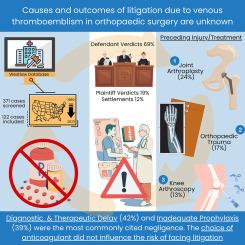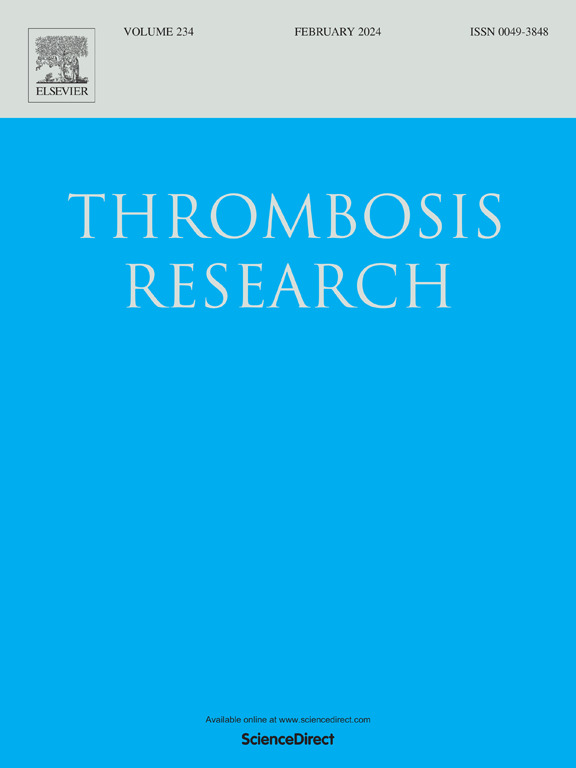Characteristics and outcomes of venous thromboembolism-related litigation in orthopaedic surgery
IF 3.4
3区 医学
Q1 HEMATOLOGY
引用次数: 0
Abstract
Background
Venous thromboembolism (VTE) is a considerable source of morbidity, mortality, and economic burden within orthopaedic surgery. Our study aimed to analyze the characteristics and reasons for lawsuits pertaining to VTE levied against orthopaedic surgeons.
Methods
The Westlaw database was queried for cases filed between 1980 and 2023 against orthopaedic surgeons involving VTE, using the search terms “orthopaedic”, “blood clot,” “deep vein thrombosis,” “venous thromboembolism,” and “pulmonary embolism.”
Results
A total of 122 out of 371 cases were selected for inclusion in this study. A defendant verdict was reached in 84 (69 %) cases and a plaintiff-verdict in 23 (19 %) cases. Fifteen (12 %) cases were settled. The mean indemnity payment and settlement award were $2.39 million and $662 thousand, respectively. Discontinuation or failure to initiate post-discharge anticoagulation therapy was cited in 25 % of cases. The most common basis of litigation was diagnostic/therapeutic delay (42 %) and inadequate VTE prophylaxis (39 %). Death was the most frequently reported complication (64 %). Patient-reported pain and suffering was associated with a defendant verdict (p = 0.0204). The choice of anticoagulant was not found to increase the risk of a plaintiff-favorable verdict (p = 0.6754).
Conclusions
Malpractice cases related to VTE in orthopaedic surgery are associated with substantial financial liability and arise in the setting of delayed diagnosis of VTE or failure to initiate thromboprophylaxis. Current medicolegal trends do not indicate a preference for any specific VTE prophylactic agent. Implementing a systems-based strategy to optimize transitions of care may help reduce both the incidence of VTE and the associated risk of litigation.

骨科手术中静脉血栓栓塞相关诉讼的特点和结果
背景:静脉血栓栓塞(VTE)是骨科手术中发病率、死亡率和经济负担的重要来源。本研究旨在分析骨科医生因静脉血栓栓塞而引发的诉讼的特点及原因。方法通过检索词“骨科”、“血栓”、“深静脉血栓形成”、“静脉血栓栓塞”和“肺栓塞”,对Westlaw数据库中1980年至2023年间涉及静脉血栓栓塞的骨科医生的病例进行查询。结果从371例患者中筛选出122例纳入本研究。84起(69%)案件作出被告判决,23起(19%)案件作出原告判决。15例(12%)结案。平均赔偿金额及和解金额分别为239万元及66.2万元。出院后抗凝治疗中断或未能启动的病例占25%。最常见的诉讼基础是诊断/治疗延迟(42%)和静脉血栓栓塞预防不足(39%)。死亡是最常见的并发症(64%)。患者报告的疼痛和痛苦与被告判决相关(p = 0.0204)。抗凝剂的选择并未增加原告胜诉的风险(p = 0.6754)。结论:在骨科手术中与静脉血栓栓塞相关的小病例与大量的经济责任有关,并且发生在静脉血栓栓塞的延迟诊断或未能开始血栓预防的情况下。目前的医学趋势并没有显示出对任何特定静脉血栓栓塞预防药物的偏好。实施以系统为基础的策略来优化护理过渡可能有助于减少静脉血栓栓塞的发生率和相关的诉讼风险。
本文章由计算机程序翻译,如有差异,请以英文原文为准。
求助全文
约1分钟内获得全文
求助全文
来源期刊

Thrombosis research
医学-外周血管病
CiteScore
14.60
自引率
4.00%
发文量
364
审稿时长
31 days
期刊介绍:
Thrombosis Research is an international journal dedicated to the swift dissemination of new information on thrombosis, hemostasis, and vascular biology, aimed at advancing both science and clinical care. The journal publishes peer-reviewed original research, reviews, editorials, opinions, and critiques, covering both basic and clinical studies. Priority is given to research that promises novel approaches in the diagnosis, therapy, prognosis, and prevention of thrombotic and hemorrhagic diseases.
 求助内容:
求助内容: 应助结果提醒方式:
应助结果提醒方式:


